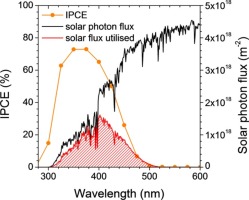Catalysis Today ( IF 5.2 ) Pub Date : 2017-11-10 , DOI: 10.1016/j.cattod.2017.11.014 Andreas Kafizas , Xueting Xing , Shababa Selim , Camilo A. Mesa , Yimeng Ma , Claire Burgess , Martyn A. McLachlan , James R. Durrant

|
Bismuth vanadate (BiVO4) has emerged as one of the most promising photoanode materials for oxidising water due to its visible light activity and low cost. Recent studies have shown that the performance of BiVO4 photoanodes can be remarkably improved when coated with ultra-thin passivation layers. In this article we investigate the use of ultra-thin Al2O3 layers grown using atomic layer deposition (ALD). At an optimum thickness (∼0.33 nm, 3 ALD cycles), the Al2O3 layer favourably shifted the onset potential by ∼200 mV and increased photocatalytic currents for the water oxidation reaction. When held at 1.23 VRHE, we observe a remarkable increase in the theoretical solar photocurrent; from ∼0.47 mAcm−2 in uncoated BiVO4 to ∼3.0 mAcm−2 in Al2O3-coated BiVO4. Using transient photocurrent (TPC) and transient absorption spectroscopy (TAS) the charge carrier dynamics in Al2O3-coated BiVO4 photoanodes were examined for the first time. TPC showed that photogenerated electrons in the BiVO4 layer were extracted within ∼1 ms. TAS showed that the remaining holes oxidised water from ∼100 ms to 1 s. Ultra-thin Al2O3 coatings did not improve the reaction kinetics towards water oxidation, but rather, suppressed bi-molecular recombination on the μs-ms timescale in BiVO4, and increased the yield of long-lived holes on the ms-s timescale required to oxidise water. This is attributed to an inhibition of surface recombination on BiVO4 by Al2O3, which inhibited the early timescale recombination of charge carriers formed within the space charge layer.
中文翻译:

BiVO 4光电阳极上的超薄Al 2 O 3涂层:对性能和载流子动力学的影响
钒酸铋(BiVO 4)由于其可见光活性和低成本而成为最有希望的用于氧化水的光阳极材料之一。最近的研究表明,当涂有超薄钝化层时,BiVO 4光电阳极的性能可以得到显着改善。在本文中,我们研究了使用原子层沉积(ALD)生长的超薄Al 2 O 3层的使用。在最佳厚度(约0.33 nm,3个ALD循环)下,Al 2 O 3层可将起始电势良好地偏移约200 mV,并增加了水氧化反应的光催化电流。保持在1.23 V RHE时,我们发现理论太阳光电流显着增加;从~0.47 MACM -2在未涂覆的BiVO 4至〜3.0 MACM -2以Al 2 ö 3涂覆的BiVO 4。使用瞬态光电流(TPC)和瞬态吸收光谱(TAS),首次检测了Al 2 O 3涂层的BiVO 4光阳极中的载流子动力学。TPC显示BiVO 4层中的光生电子在约1毫秒内被提取。TAS显示,剩余的孔在约100 ms到1 s的时间内将水氧化。超薄Al 2 O 3涂层没有改善水氧化的反应动力学,而是在BiVO 4中以μs-ms的时间尺度抑制了双分子重组,并以ms-s的时间尺度增加了氧化水所需的长寿命空穴的产率。这归因于Al 2 O 3抑制BiVO 4上的表面重组,从而抑制了在空间电荷层内形成的载流子的早期时标重组。









































 京公网安备 11010802027423号
京公网安备 11010802027423号